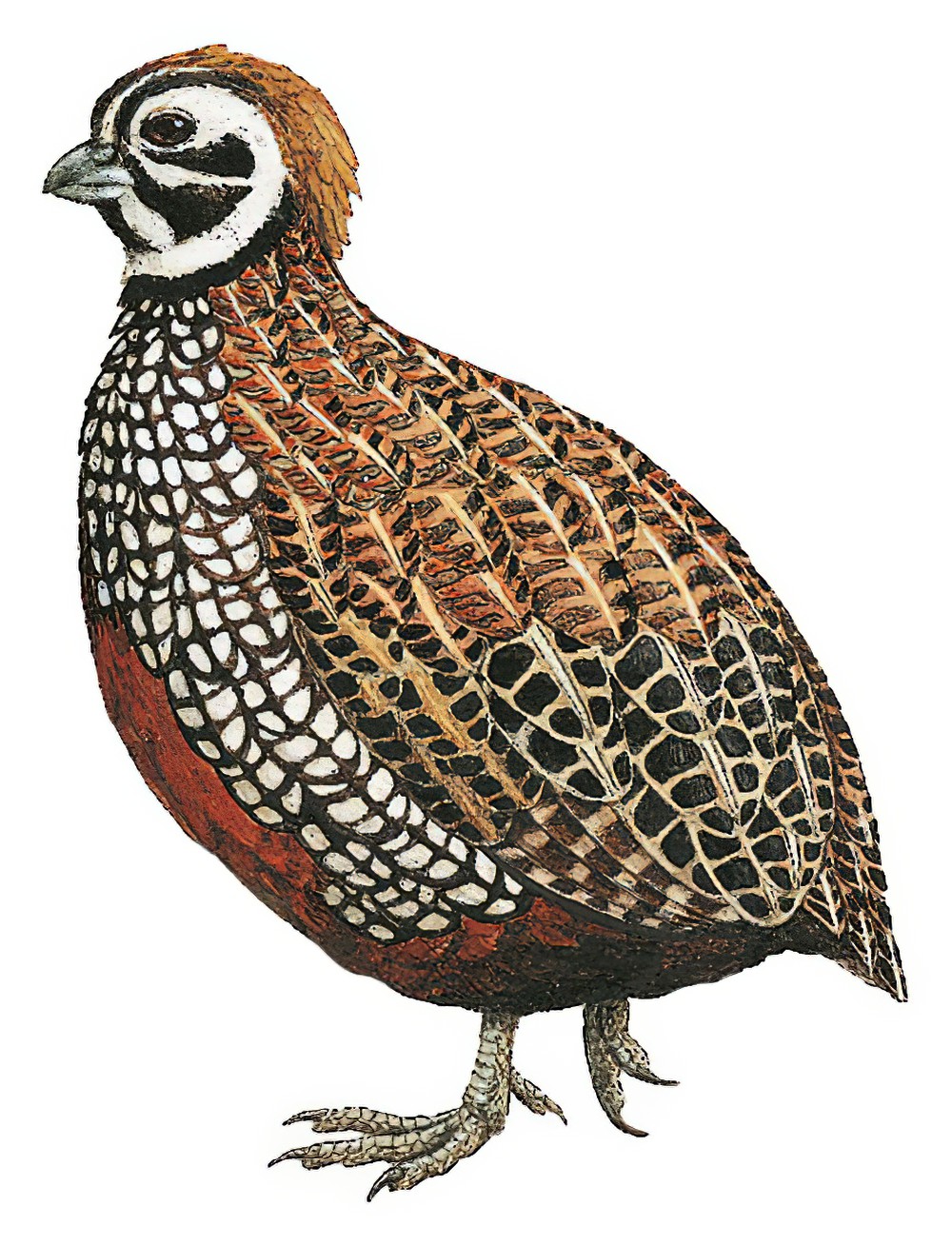Montezuma Quail / Cyrtonyx montezumae

Montezuma Quail
SCI Name:
Protonym: Ortyx Montezumae Zool.J. 5 p.275
Taxonomy: Galliformes / Odontophoridae / Cyrtonyx
Taxonomy Code: monqua
Type Locality: Mexico
Author: Vigors
Publish Year: 1830
IUCN Status:
DEFINITIONS
CYRTONYX
(Odontophoridae; Ϯ Montezuma Quail C. montezumae) Gr. κυρτος kurtos curved < κυπτω kuptō to stoop; ονυξ onux, ονυχος onukhos nail, claw; "CYRTONYX MASSENA. Massena's Partridge. ... No account whatever has yet reached us of the habits and economy of this species, which, judging from the comparative shortness of its toes and the great development of its claws, we may expect to be different from those of the other members of the family. The male is rendered exceedingly conspicuous by the singular disposition of the markings of the face, which are very strongly contrasted, and forcibly remind one of the painted face of the clown in a pantomime; the female on the other hand is very different in colour, and in the markings of the upper surface closely resembles the Common Quail of Europe." (Gould 1844); “The second section comprises two species, which, from the great size of their nails, I propose to form into a distinct genus under the title of CYRTONYX ... unguibus magnis, elongatis, curvatis, ad apicem crassis. ... nails very large, much lengthened, curved and thick at the point” (Gould 1850); "Cyrtonyx Gould, Monogr. Odontoph., pt. 1, 1844, pl. [2] and text [= pl. 7 of bound volume]. Type, by monotypy, Ortyx massena Lesson = Ortyx montezumae Vigors." (Peters, 1934, II, p. 57).
montezuma / montezumae
Montezuma or Moctezuma Xocoyotzin (1480-1520) Emperor of the Aztecs, who died of wounds inflicted by his own subjects enraged at the support he gave to the Spanish conquistadores (Cyrtonyx, Psarocolius).
SUBSPECIES
Montezuma Quail (Montezuma)
SCI Name: Cyrtonyx montezumae [montezumae Group]
CYRTONYX
(Odontophoridae; Ϯ Montezuma Quail C. montezumae) Gr. κυρτος kurtos curved < κυπτω kuptō to stoop; ονυξ onux, ονυχος onukhos nail, claw; "CYRTONYX MASSENA. Massena's Partridge. ... No account whatever has yet reached us of the habits and economy of this species, which, judging from the comparative shortness of its toes and the great development of its claws, we may expect to be different from those of the other members of the family. The male is rendered exceedingly conspicuous by the singular disposition of the markings of the face, which are very strongly contrasted, and forcibly remind one of the painted face of the clown in a pantomime; the female on the other hand is very different in colour, and in the markings of the upper surface closely resembles the Common Quail of Europe." (Gould 1844); “The second section comprises two species, which, from the great size of their nails, I propose to form into a distinct genus under the title of CYRTONYX ... unguibus magnis, elongatis, curvatis, ad apicem crassis. ... nails very large, much lengthened, curved and thick at the point” (Gould 1850); "Cyrtonyx Gould, Monogr. Odontoph., pt. 1, 1844, pl. [2] and text [= pl. 7 of bound volume]. Type, by monotypy, Ortyx massena Lesson = Ortyx montezumae Vigors." (Peters, 1934, II, p. 57).
Montezuma Quail (Salle's)
SCI Name: Cyrtonyx montezumae sallei/rowleyi
CYRTONYX
(Odontophoridae; Ϯ Montezuma Quail C. montezumae) Gr. κυρτος kurtos curved < κυπτω kuptō to stoop; ονυξ onux, ονυχος onukhos nail, claw; "CYRTONYX MASSENA. Massena's Partridge. ... No account whatever has yet reached us of the habits and economy of this species, which, judging from the comparative shortness of its toes and the great development of its claws, we may expect to be different from those of the other members of the family. The male is rendered exceedingly conspicuous by the singular disposition of the markings of the face, which are very strongly contrasted, and forcibly remind one of the painted face of the clown in a pantomime; the female on the other hand is very different in colour, and in the markings of the upper surface closely resembles the Common Quail of Europe." (Gould 1844); “The second section comprises two species, which, from the great size of their nails, I propose to form into a distinct genus under the title of CYRTONYX ... unguibus magnis, elongatis, curvatis, ad apicem crassis. ... nails very large, much lengthened, curved and thick at the point” (Gould 1850); "Cyrtonyx Gould, Monogr. Odontoph., pt. 1, 1844, pl. [2] and text [= pl. 7 of bound volume]. Type, by monotypy, Ortyx massena Lesson = Ortyx montezumae Vigors." (Peters, 1934, II, p. 57).
UPPERCASE: current genus
Uppercase first letter: generic synonym
● and ● See: generic homonyms
lowercase: species and subspecies
●: early names, variants, mispellings
‡: extinct
†: type species
Gr.: ancient Greek
L.: Latin
<: derived from
syn: synonym of
/: separates historical and modern geographic names
ex: based on
TL: type locality
OD: original diagnosis (genus) or original description (species)












